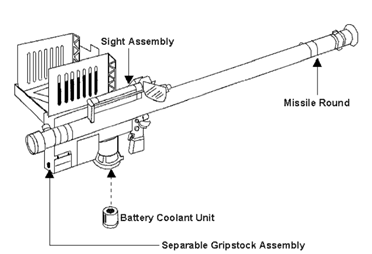Comparative Analysis
The Stinger weapon round (Figure 2) is shipped from the ammunition supply point in a crush resistant, hardened, reusable aluminum box. It is certified for immediate firing. This box is called the weapon round container, but is more commonly referred to as a mono box. Stinger rounds are packaged in a thin, wood-sided box surrounding a foam insert in which the missile is packed. The boxes are known as “lettuce crates” because of their similarity to produce boxes. The Stinger weapon round consists of a missile round, a separable gripstock assembly, and up to three battery coolant units (BCUs). The gripstocks are shipped separately from the missile to enhance security during shipping.

Fig. 2 Stinger Weapon Round
The missile round consists of a Stinger missile sealed in a launch tube with an attached sight assembly. The sight assembly allows the gunner to range and track an aircraft. Two acquisition indicators are mounted on the sight assembly. The first, a speaker, allows the gunner to hear the IR acquisition signal and IFF tones when interrogations are made through the IFF subsystem. The second indicator is a bone transducer that allows the gunner to “feel” the IR acquisition signal on the cheekbone. Also attached to the sight is a clear plastic eye shield that protects the gunner’s left eye when the missile is fired.
The gripstock consists of the gripstock assembly and the IFF antenna assembly. The gripstock assembly contains all of the circuits and components required to prepare and launch the missile as well as the interface for the IFF subsystem. The gripstock is of a clamshell design so that internal components and circuitry within the gripstock can be serviced by qualified technicians at depot-level maintenance. After the missile is launched, the gripstock is removed from the launch tube for attachment to a missile round.
When the IFF antenna assembly is unfolded and the IFF interrogator is connected to the weapon, the gunner can interrogate aircraft and receive coded replies. The gripstock also houses the auxiliary unit interface, where the reprogrammable microprocessor read-only memory (ROM) module is located. It is accessed through an interface connector cover on the left side of the gripstock. Advanced counter-countermeasure technology can update current missiles in the same manner. The read-only memory interface allows technicians to access the electronics section and install the updated modules into the missiles.
The battery coolant unit contains a thermal battery that provides power for pre-flight system operations and a supply of argon gas to cool the IR detector in the missile seeker. Once activated, the BCU supplies electrical power and seeker coolant until the missile is launched or for a maximum of 45 seconds. The battery coolant unit is removed from the gripstock BCU well and discarded immediately after use.
Compare Stinger vs SA-7 Grail architectures.